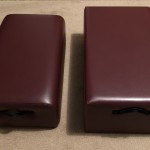Issue #264 & #265- Wednesday, May 8 – 15, 2019
IT DOES MATTER!
By Sabrina Svard
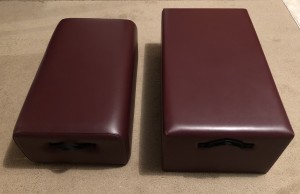
I couldn’t figure out what was wrong. How did I get so weak so fast? None of this made any sense. I tried everything. I moved forward on the box. I moved backward on the box. I put the box over the shoulder blocks. I put the box in front of the shoulder blocks. I moved the carriage forward. I moved the carriage backward. I used the long loops and then the short loops – all to no avail. I changed springs at least seventeen times. Light spring, heavy spring, two springs, one spring, and all that was happening was that I was getting sprung!!! I fussed and I fumed.
I. Just. Could. Not. Do. It.
I just could not do full teaser on the box!!! This could not be so! What happened? I was mortified.
REWIND:
I have a bit of a crazy Pilates journey spanning more than 25 years that may explain why I couldn’t get up into teaser on THAT box. I opened my first (contemporary) studio in 2004. Shortly after that, I attended a weekend classical-mat training. A few years later, I enrolled in a more serious contemporary-mat Pilates training. Then, just three years after I had opened my contemporary studio, I bridged into a classical system. What an eye-opener that was! I purchased classical-style apparatus and changed my teaching methodology to reflect the classical repertoire.
FAST FORWARD:
After ten years, I was done teaching Pilates (or so I thought) and moved to New Mexico to “bartend and be a bum.” But, after a few month’s rest, I started teaching contemporary Pilates again in someone else’s studio. And now, finally, I have opened my own studio again – classical. This is when I made a massive discovery: The apparatus you are on REALLY DOES MATTER!
Finally the answer to my problem with teaser dawned on me: the box was too big! And the size and dimensions of the apparatus were only the beginning.
IT DOES MATTER:
Now that you have the background, I want to talk about some of the differences between classical reformers and contemporary reformers, and how those differences can affect the feel of some common Pilates exercises. One fascinating difference is the size of the reformer: the contemporary is much larger than the classical. Classical reformers do come in sizes: 80”, 86”, and 89”. The difference in these sizes is the well length, not the length of the carriage or distance from the footbar to the carriage. The carriage size is the same and the spring hook gearing is the same. You can push out farther on the longer reformer, but an 80” will fit most people. The classical apparatus is nearly “one size fits all.” I know that sounds crazy given that the contemporary reformer is longer and wider and has so many different adjustments in the gears, the footbar, and the springs. The four springs on classical reformers all have the same resistance. Contemporary reformers have a rainbow of colors and resistances to match. I thought I would want all those adjustments and options and would miss them. Guess what? I don’t miss them at all. Bear with me and please keep reading!
FOOTWORK:
You will immediately notice the difference between classical and contemporary reformers when doing footwork. Springs are heavier, and yet smoother, on the classical reformer. The ride is smoother because there is resistance (drag) on the wheels of the classical apparatus, and the carriage doesn’t get yanked back in by the springs. Instead, your powerhouse brings the carriage in. The wheels on a contemporary reformer are very smooth and slick – they do not make you work to get the carriage back in. The springs pull you back in. So, on classical reformers, you must work on the push out and often work even harder on the pull back in! No, you cannot just put heavier springs on your contemporary apparatus with non-resistance wheels. All those heavy springs will do with those slick wheels is pull the carriage back in faster and with less work from your body. This isn’t quite as noticeable on footwork but it is in other exercises. Stay tuned…
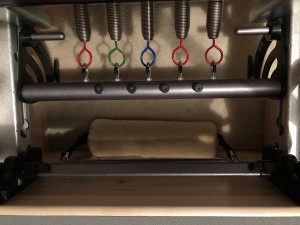
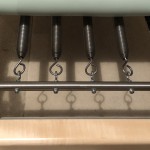
The footbar is also different on the two reformers. It is slightly lower on a classical reformer. Contemporary reformers have heavily padded footbars. Classical reformers can have a padded footbar, but most often the footbar has little (called direct-contact) or no padding – I have both. If you are doing 10 or 12 contemporary footwork exercises on a direct-contact, unpadded footbar, it is not comfortable at all. But you do feel your feet! Classical footwork has 4 exercises. Direct-contact allows for that: more direct contact, more feeling, better grip, and more whining until you get used to it! Additionally, there are only two positions on classical reformer footbars: up or down. Classical footbars are all quick release; that is, they do not lock in place, which allows you to put the footbar down with your feet as part of the flow of the classical Pilates system. Contemporary footbars have several adjustments and lock – that definitely comes in handy at times – but there is no quick release feature. This is annoying if you’re doing classical flow on a contemporary reformer.
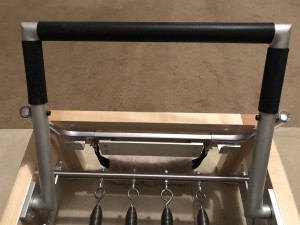
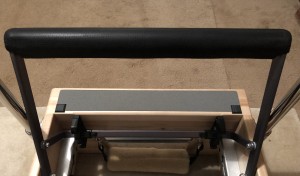
THE HUNDRED:
We know that the springs are heavier and the wheels have resistance on the classical apparatus. Therefore, the 100 is harder and deeper. The classical leather straps with handles are more comfortable than the contemporary ropes with loops (as if the 100 is ever comfortable), especially if your clients have arthritic hands. Typically, the 100 is done on footwork springs. The push forward into the handles with the deep scoop back into the powerhouse and the reach with the legs is extremely effective on the classical apparatus. Heavy springs on contemporary apparatus can often make you feel like you are fighting with the springs and thus not deepening the work.
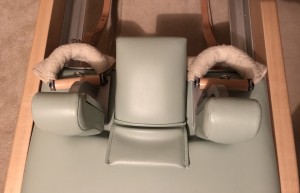
Another thing to consider with the Hundred, and several other exercises, is the line of pull on the straps. On a classical reformer, the pull is coming from inside the frame and slightly up. This causes you to pull back more into the powerhouse. On a contemporary reformer, the line of pull is often coming from several inches above the frame and down. This changes the dynamic of the work. It doesn’t sound like that big of a deal, but it does matter!
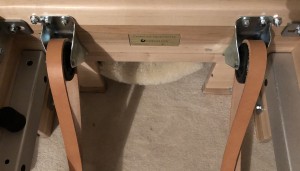
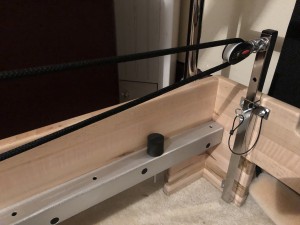
The Hundred is a great place to end Part 1 of our discussion about how and why the apparatus you are on REALLY DOES MATTER!. We’ll pick this up again in the next edition to talk about more of the Pilates repertoire, wrapping up with my original nemesis – Teaser!
LONG-STRETCH SERIES, KNEE STRETCH, TENDON STRETCH:
Imagine doing these exercises with springs and wheels that don’t help much to pull you back in. If you’re familiar with fitness training, this feels like using gliding discs under your feet, and you must really use your powerhouse to pull in. You can get this same effect by using paper plates on carpet or a wood floor to do long stretch, knee stretch and a pike similar to tendon stretch to get the feel of that deep scoop with resistance in both directions. The photos illustrate how to do this for yourself or to teach your clients how to get that deep scoop for inversions.
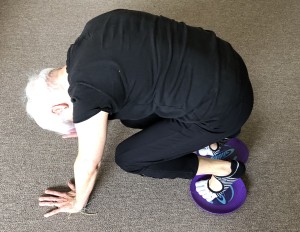
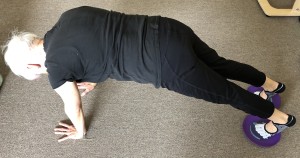
I was so proud to be able to do all of the advanced versions of tendon stretch (aka Pommel Horse in gymnastics), and then I got on a classical reformer with resistance on the wheels. It felt like being back at square one and having to build strength all over again in the powerhouse to pull that carriage in. Pulling the carriage in with two legs was challenging enough, never mind using just one leg! Again, the springs don’t return the carriage much on classical reformers. It is your powerhouse that does. In other words, it is very difficult to cheat using the classical apparatus. You will need to work harder! But think of how much strength and control you will gain!
All of the exercises where you are upside down and scooping the powerhouse from down under and up are super challenging but also super STRENGTHENING on the classical apparatus. Envision long stretch with little help returning the carriage. It feels a little bit like pulling through smooth sand. Elephant, arabesque, tendon stretch, and knee stretches (particularly knees off) all need a deep powerhouse scoop to return and close the carriage entirely with heavier springs and slight resistance on the wheels. It’s a whole new ballgame!
PULLING STRAPS I & II (AIRPLANE/T):
Again, a heavier spring with resistance wheels on the classical reformer makes these exercises super challenging. It is also a bit odd because the carriage returns very slowly due to the resistance on the wheels and the body weight on the box. There is a slight period of little or no tension on the straps as the carriage returns to start. Clients do find this annoying. I am now used to this because I enjoy the renewed challenge of the exercises.
LONG SPINE & EXTENSION STRAPS:
Think about long spine on a classical reformer with a little heavier spring load and resistance on the wheels. . .it is glorious! You almost feel like you’re flying! You get more support and control, which is great. But what about those silly extension straps?
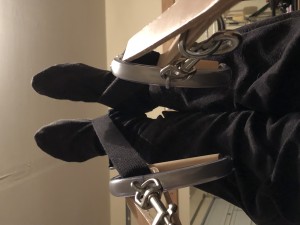
Surprisingly, I get complaints from clients when they use the extension straps for doing contemporary work. In the classical system, feet in straps is only for frogs and leg circles in the beginner series and then only for long spine in the advanced levels. So the handles and leather loops held in the extension straps are not annoying since so few of the exercises are actually done with them in the classical system. I use Strapilates when teaching contemporary feet in straps.
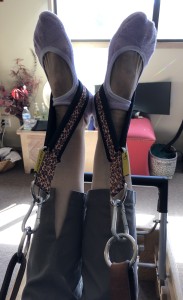
TEASER:
At last, the fateful exercise that started it all: Full teaser on the box. This exercise is a challenge no matter what apparatus you choose. So to talk about my dilemma, yes, size also matters! I couldn’t get myself situated correctly on a contemporary box to do teaser. Contemporary long/short boxes are much bigger than the classical long/short boxes. Remember, overall, the contemporary apparatus is much bigger than classical. It is wider and longer and has larger shoulder blocks, footbar, carriage, long/short box, etc. This reformer was designed to fit a wide variety of clients. And also remember those 5 springs offer a much wider variety of resistances. These are all good things, and I can’t believe I am going to type this out loud, but I have found them to be unnecessary for most clients.
In the case of teaser on a contemporary reformer, I couldn’t get myself situated for the exercise, because the box was far too big. Had I been 6’ 5” I am sure it would have been fine. But a standard-size classical reformer and its box will accommodate just about anyone between 5’ and 6’ tall. Yes, really, it is true! So all those adjustments are super, but the average person doesn’t need them.
Now imagine having that line of pull on the straps coming from inside the frame and up, as it does on the classical reformer, and having a bit heavier spring and resistance on the wheels. IT IS KILLER! I say that with sheer delight – really I do (for I am a Pilates FREAK!). But now envision the contemporary reformer with the line of pull coming from level with the box or from even slightly down, and a heavier spring and slick wheels: now that will just about yank you off the box backward since the heavier spring just wants to pull you back. A very different kind of strength and control is required with each reformer type. Having both classical and contemporary options to use would be great for the contrast and to generate strength and control.
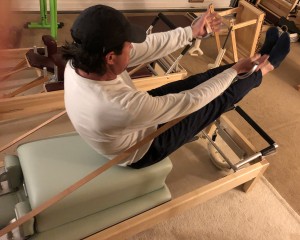
IT DOES MATTER!
To summarize, both types of reformers have advantages and disadvantages depending on the exercise. I will say that if you are a contemporary Pilates instructor, then of course contemporary apparatus would best suit your needs and vice versa for a classical instructor. In a perfect world, if you teach both styles, you would have both kinds of apparatus.
I would like to reiterate that I did not write this piece to sway anyone in the direction of either classical or contemporary apparatus. Please realize that there is much more to discuss regarding the two different ways of Pilates training and how all of the other apparatus compare and contrast. My mission was to explain some of the differences between the classical reformer and the contemporary reformer, and how they can affect the feel of common Pilates exercises.
I encourage all of you to go forth and experience all kinds of Pilates – both training and apparatus – if the opportunity presents itself. I actually think you should seek out those opportunities! I strongly feel that over time, by experiencing different training methods and different apparatus, you will migrate to the style or method of Pilates that works for you. It took me 20 years and I went back and forth what seems like 20 times! I’m hoping for easily another 20 years of a system that knows no age!


